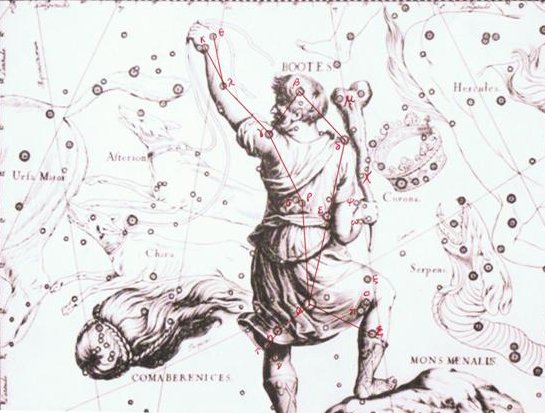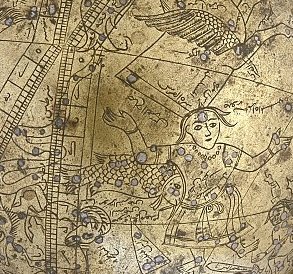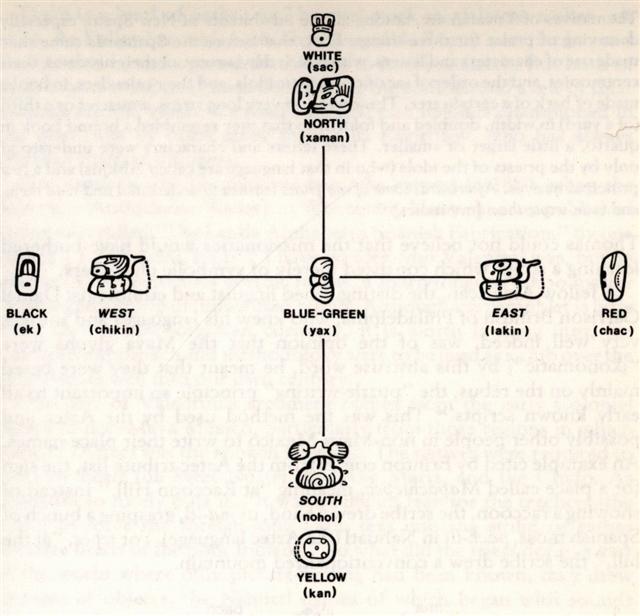36. We should remember there was a glyph complex also at FEBRUARY 17 (14 * 29½) towards the end of line Gb7:
Terminalia at the time of Hyadum II came 6 days later, and this should be the case also in the C text:
Gb7-30 could possibly have been intended to illustrate where the old year once upon a time had reached its day 413 = 14 * 29½, whereas Cb1-6 on the other hand could have depicted where once upon a time the Full Moon was at day 48 (= 413 - 365), i.e. half a year later:
South of the equator a 'break at dawn' could have arrived in October 22 (= 10 * 29½ days from January 1) when the Sun reached Arcturus. Annus (year) is not much different from anus (the place of Arcturus in Bootes).
The Egyptian view was that the pointed prow (tree) of the ship of the Sun ran into a net late in the night:
... In the arabesque of interlaced motifs, one can mark those where the theme of 'pulling down the structure' is in evidence. The powerful Maori hero Whakatau, bent on vengeance, laid hold of the end of the rope which had passed round the posts of the house, and, rushing out, pulled it with all his strength, and straightaway the house fell down, crushing all within it, so that the whole tribe perished, and Whakatau set it on fire. This is familiar. At least one such event comes down dimly from history. It happened to the earliest meetinghouse of the Pythagorean sect, and it is set down as a sober account of the outcome of a political conflict, but the legend of Pythagoras was so artfully constructed in early times out of prefabricated materials that doubt is allowable. The essence of true myth is to masquerade behind seemingly objective and everyday details borrowed from known circumstances. However that may be, in many other stories the destruction of the building is linked with a net. Saxo's Amlethus does not pull down pillars; he reappears at the banquet set by the king for his own supposed funeral, like Great-Land-Master himself. He throws the knotted carpet net prepared by his mother over the drunken crowd and burns down the hall. In Japan the parallel does not go farther than that but it has its own relevance nevertheless. It suggests the fall of the House of Atreus. The net thrown by Clytemnestra over the king struggling in his bath cannot have come in by chance. But this is an uncertain lead as yet. The Sacred Book of the ancient Maya Quiche, the famous Popol Vuh (the Book of Counsel) tells of Zipacna, son of Vucub-Caquix (= Seven Arata). He sees 400 youths dragging a huge log that they want as a ridgepole for their house. Zipacna alone carries the tree without effort to the spot where a hole has been dug for the post to support the ridgepole. The youths, jealous and afraid, try to kill Zipacna by crushing him in the hole, but he escapes and brings down the house on their heads. They are removed to the sky, in a 'group', and the Pleiades are called after them. Then there is a true avanger-of-his-father, the Tuamotuan Tahaki, who, after long travels, arrive in the dark at the house of the goblin band who tortured his father. He conjures upon them 'the immense cold of Havaiki' (the other world) which puts them to sleep. Then Tahaki gathered up the net given to him by Kuhi, and carried it to the door of the long house. He set fire to the house. When the goblin myriads shouted out together 'Where is the door?' Tahaki called out: 'Here is it.' They thought it was one of their own band who had called out, and so they rushed headlong into the net, and Tahaki burned them up in the fire. What the net could be is known from the story of Kaulu. This adventurous hero, wanting to destroy a she-cannibal, first flew up to Makalii the great god, and asked for his nets, the Pleiades and the Hyades, into which he entangled the evil one before he burned down her house. It is clear who was the owner of the nets up there. The Pleiades are in the right hand of Orion on the Farnese Globe, and they used to be called the 'lagobolion' (hare net). The Hyades were for big game ... 392 (= 365 + 27) glyphs before Cb1-6 there was a similar place, i.e. 4 days after the September equinox:
Or better: 5 days after the time when the Full Moon had been at Terminalia in Roman times. In which case 'February 28 (59) - 5 = 'February 23 (54) could have corresponded to Ca1-1 and to the night after the nakshatra position of Sirrah, to a time when the 'Navel of the Horse' had been at the Full Moon. Maui was born from the topknot of his mother:
... 'From the time I was in your womb,' Maui went on, 'I have known the names of these children of yours. Listen,' he said as he pointed to his brothers in turn. 'You are Maui mua, you are Maui roto, you are Maui taha, and you are Maui pae. And as for me, I am Maui potiki, Maui-the-last-born. And here I am.' When he had finished, Taranga had to wipe her eyes because there were tears in them, and she said: 'You are indeed my lastborn son. You are the child of my old age. When I had you, no one knew, and what you have been saying is the truth. Well, as you were formed out of my topknot you can be Maui tikitiki a Taranga.' So that became his name, meaning Maui-formed-in-the-topknot-of-Taranga. And this is very strange, because women in those days did not have topknots. The topknot was the most sacred part of a person, and only men had them ...
... Although an old constellation, Cetus is by no means of special interest, except as possessing the south pole of the Milky Way and the Wonderful Star, the variable Mira; and from the fact that it is a condensation point of nebulae directly across the sphere from Virgo, also noted in this respect ... ... Mira also known as Omicron Ceti (ο Ceti, ο Cet), is a red giant star estimated 200-400 light years away in the constellation Cetus. Mira is a binary star, consisting of the red giant Mira A along with Mira B. Mira A is also an oscillating variable star and was the first non-supernova variable star discovered, with the possible exception of Algol. Apart from the unusual Eta Carinae, Mira is the brightest periodic variable in the sky that is not visible to the naked eye for part of its cycle ... In a way Mira therefore can illustrate how life (light) departs, yet returns again after the completion of a cycle. ... In 1638 Johannes Holwarda determined a period of the star's reappearances, eleven months; he is often credited with the discovery of Mira's variability. Johannes Hevelius was observing it at the same time and named it 'Mira' (meaning 'wonderful' or 'astonishing,' in Latin) in 1662's Historiola Mirae Stellae, for it acted like no other known star. Ismail Bouillaud then estimated its period at 333 days, less than one day off the modern value of 332 days, and perfectly forgivable, as Mira is known to vary slightly in period, and may even be slowly changing over time ...
Quite possibly we have to think like Waman Puma when reading the rongorongo texts - moving in time when following the stars and the glyphs: ... Space and time are a single, related concept in Runasimi [the language of the Inca people], represented by one word, pacha, which can also mean 'world' and 'universe'. The image of time familiar to Waman Puma was static and spatial: one could travel in time as one travels over earth - the structure, the geography, remaining unchanged. To him it does not matter that he shows Inka Wayna Qhapaq, who died in 1525, talking to Spaniards who did not arrive until 1532. Wayna Qhapaq was the last Inca to rule an undivided empire: he is therefore the archetype, and it must be he who asks the Spaniards. 'Do you eat gold?' In Andean thought both world and time were divided into four sectors or directions unified under a presiding fifth principle. The Tawantinsuyu - 'the indivisible four quarters' - was unified and presided over by Cusco, the center. Similarly, history was divided into four previous ages, presided over by a fifth, the present. In his book, Waman Puma organizes the history of both Old and New worlds according to this scheme. The Old Testament and the pre-Inca times are each divided into four equivalent and parallel ages. The 'present' age in Peru begins with the appearance of Manku Qhapaq, the first Inca, a being of supernatural origin. And in the Old World the 'present' starts with the birth of Jesus Christ ...
|
|||||||||||||||||||||||||||||||||||||||||||||||||||||||||||||||||||||||||||||||||||||||||||||||||||||||||||||||||||||||||||||||||||||||||||||||||||||||||||||||||||||||||||||||||||||||||||||||||||||||||||||||||||||||||||||||||||||||||||||||||||||||||||||||||||||||||||||||||||||||||||||||||||||||||||||||||||||||||||||||||||||


























